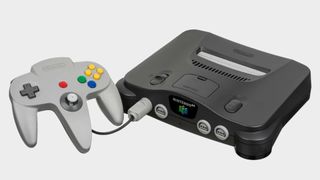This hero turned a Nintendo N64 into a mini PC with an old Intel NUC
But not without some hiccups.

Creative soul and SweClockers frequenter, Shinzou has successfully turned the chassis of a broken down N64 into a home entertainment system, using a medley of printed parts and PCBs from some old Intel NUC machines. This is the NUC64 and their story.
According to the device's creator, the initial plan was to use a Raspberry Pi in the N64 shell to create the "game and media machine" for use with their TV. But when they found their old, small form factor NUC machine, the idea took on a whole new form.
Then, it was "time to start playing."
First off, Shinzou found that the NUC's power adapter did fit in the N64's AC adapter, with some caveats. It seems the N64s adapter uses a DC plug, which would carry 12V and 3.3V to the console, whereas they note "mine runs 19V over these instead! I will print a sticker and put it on, at least some security…"
Unfortunately, unknowing of what had possessed them to do so, Shinzou managed to throw away PCB pieces that included the original front connectors and power connection for the N64, so there was no housing for the new sockets. Attempts to 3D print new housing turned out badly, so Shinzou turned to eBay to get some replacement sockets.
Soon, Shinzou discovered their NUC was too old to run KODI or PLEX on Windows or Linux "without hacking something terrible." So they made the decision to purchase a newer NUC8i3BEK and restart the whole process. Now, that's a level of perseverance I can get behind.

Best CPU for gaming: the top chips from Intel and AMD
Best graphics card: your perfect pixel-pusher awaits
Best SSD for gaming: get into the game ahead of the rest
With this second iteration, another mistake surfaced—a discrepancy in wattage. Shinzou's older NUC required 65W to run, whereas the new one was a little thirstier at 95W. This didn't stop them, though. After some searching they discovered the device should, in theory, only draw about 50-55W. And confirming this trough stress testing with a wattmeter, they decided to run with it.
The biggest gaming news, reviews and hardware deals
Keep up to date with the most important stories and the best deals, as picked by the PC Gamer team.
Why not live life on the edge? I say.
The most beautiful feature of all, is that inside the removable cartridge is where the storage expansion sits. It works via an mSATA disk and an mSATA to SATA adapter, not the speediest solution, but attempts made with SSDs sadly didn't work.
The final build is controlled via a stripped down and hacked together Flirc-IR and Logitech Harmony control combo, and it works well for both music and movies. The only real disappointment for Shinzou was in having to cut a big hole in the bottom of the N64 chassis, but this was necessary to house the cooling solution—without it "the computer died during Steam streaming."
A word of encouragement from the designer, should you ever feel like giving up on your projects: "sometimes I just wanted to throw everything in the trash and forget about it, but you must never give up when you know that it is doable with your projects."
Well said, Shinzou. As always, keep doing what you're doing, you beautiful modders.

Screw sports, Katie would rather watch Intel, AMD and Nvidia go at it. Having been obsessed with computers and graphics for three long decades, she took Game Art and Design up to Masters level at uni, and has been rambling about games, tech and science—rather sarcastically—for four years since. She can be found admiring technological advancements, scrambling for scintillating Raspberry Pi projects, preaching cybersecurity awareness, sighing over semiconductors, and gawping at the latest GPU upgrades. Right now she's waiting patiently for her chance to upload her consciousness into the cloud.
Most Popular




